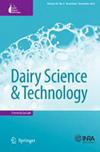A New Approach in the Evaluation of Dairy Camels: Using Test Day Milk and Morphometric Records
Q2 Agricultural and Biological Sciences
引用次数: 4
Abstract
In the case of camels, there is little data in the literature on the relationship between body building features and the evaluation of milk yield. In the last decade, a rising interest in camel milk has been observed due to its nutritional and health-promoting properties, resulting in a growing market demand. Despite the remarkable importance of camels, very little improvement in camel breeding and selection for dairy purposes has been achieved. The current study aimed to provide a practical approach to the evaluation of dairy dromedaries based on test day milk and morphometric records. A total of 62 Sindi dairy camels were evaluated and 4176 daily milk records were registered in February, March, April, and May 2021. She-camels were milked twice per day (at morning and evening) by hand before calf sucking. The farming system was intensive with two times feeding. Three measurements had the highest scores in assessing: udder, teats distance and placement, and teats size, which included 45 out of 100 scores. Test day milk records were analysed using a simple repeatability model with two random effects. The range of daily milk yields was estimated between 0.1 to 8.70 kg. The mean of body scores was 77.19 (CI = 74.19–80.19). Daily milk yields moderately correlated with body score (r = +0.27). Additionally, udder circumference and abdomen girth were correlated to milk production. Using test day milk records in breeding programs can be appropriate for the selection and replacement of she-camels, but due to difficulties in accessing these data, using morphometric data is a good criterion for the evaluation of dromedaries in extensive systems.一种评价乳骆驼的新方法:利用试验日乳和形态计量记录
以骆驼为例,关于体型特征与产奶量评价之间关系的文献资料很少。在过去十年中,由于其营养和促进健康的特性,人们对骆驼奶的兴趣日益浓厚,导致市场需求不断增长。尽管骆驼具有显著的重要性,但在骆驼的育种和乳品选择方面几乎没有取得任何进展。本研究旨在提供一种基于测试日奶和形态测量记录的奶牛单峰骆驼评估的实用方法。在2021年2月、3月、4月和5月,共对62头Sindi产奶骆驼进行了评估,并登记了4176例每日产奶记录。母骆驼每天在吸吮小牛之前用手挤奶两次(早上和晚上)。耕作制度是集约化的,两次饲养。在评估中,有三项指标得分最高:乳房、乳头距离和位置,以及乳头大小,满分100分,其中45分。试验日牛奶记录采用具有两个随机效应的简单重复性模型进行分析。日产奶量估计在0.1至8.70公斤之间。体评分平均值为77.19 (CI = 74.19 ~ 80.19)。日产奶量与体重评分呈正相关(r = +0.27)。此外,乳围和腹围与产奶量相关。在育种计划中使用试验日产奶记录可以用于母骆驼的选择和替换,但由于难以获取这些数据,使用形态计量学数据是在广泛系统中评估单峰骆驼的一个很好的标准。
本文章由计算机程序翻译,如有差异,请以英文原文为准。
求助全文
约1分钟内获得全文
求助全文
来源期刊

Dairy Science & Technology
农林科学-食品科技
CiteScore
2.30
自引率
0.00%
发文量
0
审稿时长
2 months
期刊介绍:
Information not localized
 求助内容:
求助内容: 应助结果提醒方式:
应助结果提醒方式:


